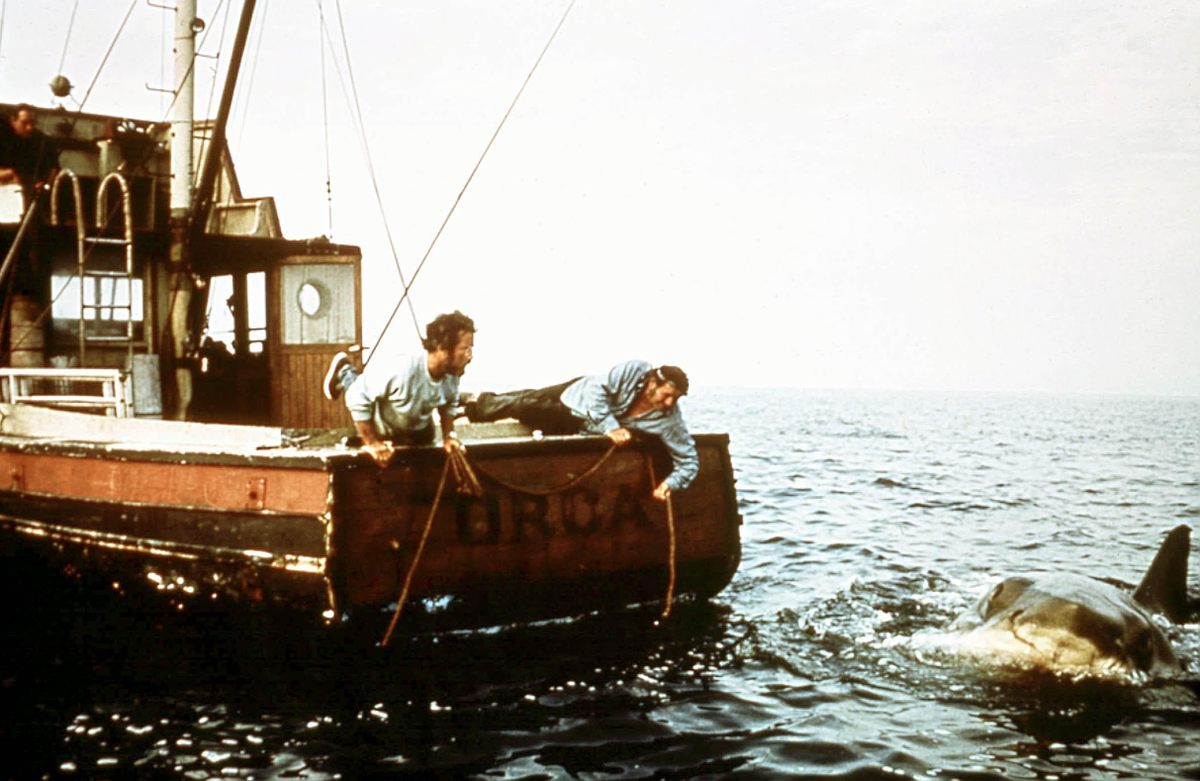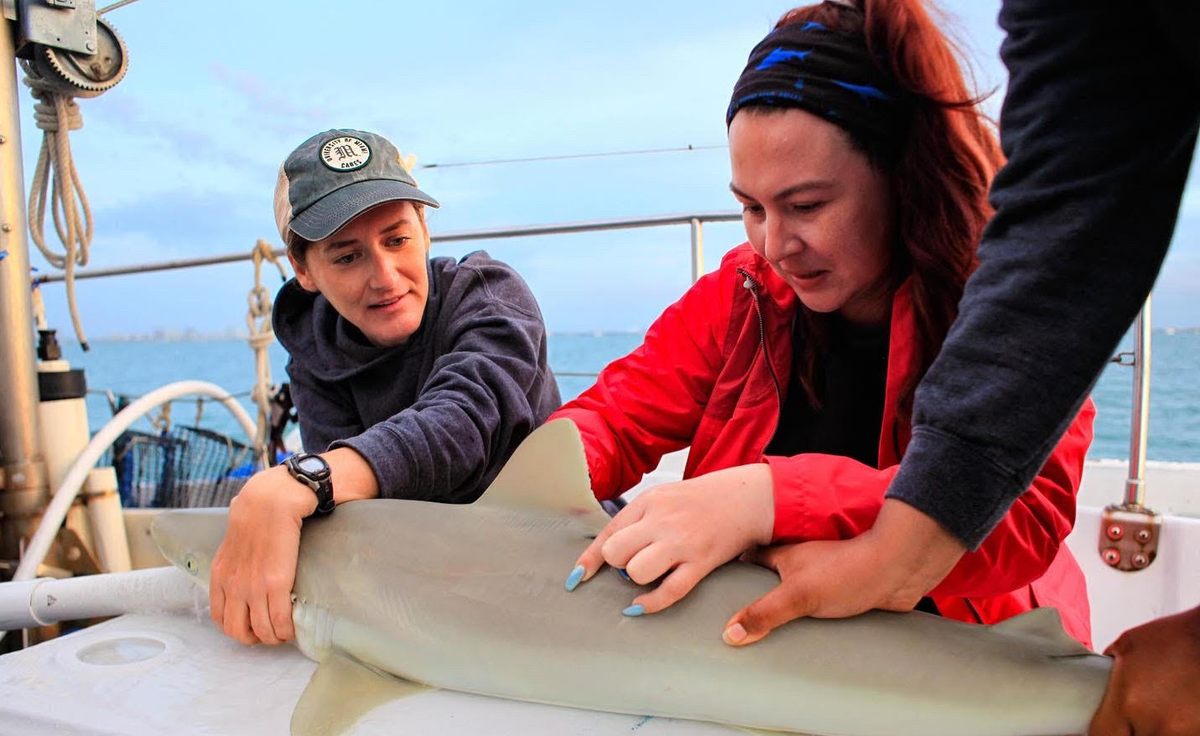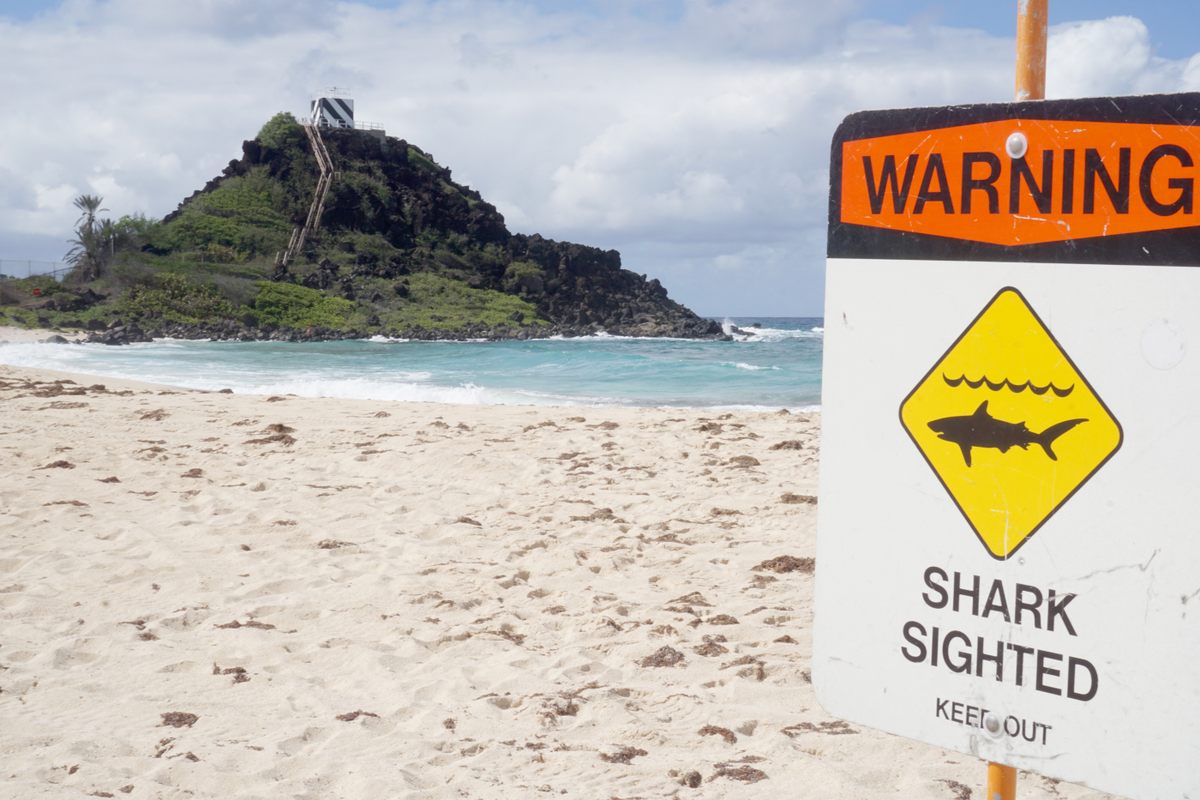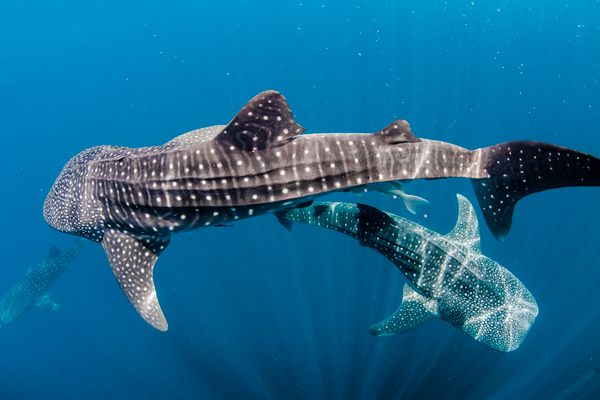Sharks Have Long Caused Trouble for Filmmakers
The predators may react when camera crews come poking around, but it doesn’t make them villains.
In May 1974, a 27-year-old director named Steven Spielberg set out to make a movie about a shark, based on a hit novel that had come out just months earlier, also about a shark. In August 2023, a new Broadway play is opening at the Golden Theater on West 45th Street in New York, The Shark Is Broken, about the trials, tribulations, and humor of the making of the movie—Jaws, obviously—that changed the film industry.
The play dramatizes the bickering between three stars of the film—Richard Dreyfuss, Roy Scheider, and Robert Shaw, whose son Ian co-wrote and stars in the play—and the difficulties of having a giant, animatronic shark as a scene partner. Back in 1974, it wasn’t just the fake shark that presented challenges—the production was menaced by real live sharks before the real filming ever started. And this isn’t the only time sharks—as cast members or uninvited guests—have made life difficult for filmmakers of all sorts.
Jaws’ largest and most iconic cast member, dubbed Bruce, was actually three different mechanical sharks—and for a couple scenes, was played by a real great white. Before filming started in Martha’s Vineyard, Massachusetts, a crew went to Australia to get some cage-diving close-ups with a great white. Two turns of events changed the course of the movie. Problem one: The stuntman refused to get in the cage; we’ll see why in a second. Problem two: Sharks don’t take direction. One ended up ripping apart the dive cage on film. The footage was too good to waste, so Spielberg and his team changed the plot from the book so they could use it.

Fast forward to June 2023, when a Netflix crew filming David Attenborough’s Our Planet II was harassed by sharks off the coast of one of Hawaiʻi’s most remote islands, Laysan. “This ’V’ of water came streaming toward us and this tiger shark leapt at the boat and bit huge holes in it. The whole boat exploded,” producer and director Toby Nowlan told Radio Times. It was the second attack of the day, but Nowlan doesn’t seem to hold it against the sharks, adding that this behavior was “extremely unusual.”
Any kind of shark attack is indeed incredibly rare, but tiger sharks are one of the more likely culprits, says shark researcher Camila Cáceres. “There are more than 500 shark species, and maybe only three or four are considered particularly aggressive to humans,” she says. “And tiger sharks are definitely one of them.”
The documentary team had spent six weeks on the shark-infested waters following a single albatross chick, and thought they might take advantage of this situation and get a little bonus tiger shark footage, too. “The original idea was to do an underwater shoot with the tiger sharks waiting in the shallows,” series producer Huw Cordey told Forbes. “But the first day the tiger sharks were around, the crew got into these inflatable boats, and two sharks attacked them. It was like something out of Jaws.”
While tiger sharks might appear to be aggressive, especially when provoked, Cáceres says they are often just curious. “I understand why it can be a terrifying situation,” she says, but she prefers to look from the sharks’ point of view. “Sometimes there’s some interesting things so you investigate and figure out what it is.” Sharks just happen to use their toothy mouths to poke around, she explains.

The crew for a 2014 Discovery Channel Shark Week show, Lair of the Megashark, can relate. In this video, the great white the filmmakers were pursuing lunged for a rope connecting two crew members’ small dinghy to a larger boat off Stewart Island in New Zealand. The incident wasn’t particularly random. The great white was after the bait they’d set off the boat, and got tangled up their ropes.
The crew of Blue Planet II also had a run in with sharks, in 2013, except this time it was about 2,300 feet deep in the Atlantic Ocean. Their submersible came across huge sharks feeding on a sunken sperm whale carcass. In a BBC behind-the-scenes video, some of the sharks seem to get territorial with the submersible, pushing and ramming it. As the encounter progresses, the scientists’ “oohhs” and “aahhs” turn to frightened obscenities.
This definitely could have been aggression in a feeding frenzy, but sharks are also drawn to mechanical noises, says Cáceres.
These reactions from curious, intelligent, and maybe hungry sharks shouldn’t come as a surprise. Film crews, whether making a blockbuster or a nature documentary, are knowingly putting themselves out in the sharks’ domain, and perhaps even provoking them, with or without knowing it, says shark ecologist Naomi Farabaugh from Florida International University.
“We’re in their home,” she says. “”Some people often ask me, ‘What’s the best way to avoid getting bit by a shark?’ And my very first piece of advice is, ‘Don’t harass them.’”

The odds of having a negative encounter with a shark are astonishingly low, and even lower for a fatal attack. “These attacks appear to be happening more often, but really, they’re quite rare,” says Cáceres. “You’re more likely to win the lottery, or die from a coconut falling on your head, than suffering a shark attack.”
“Considering the amount of people and tourists that are at the beaches, it really is astounding that there’s not more negative shark interactions,” she adds. But that doesn’t stop the fear people have picked up from Jaws, and countless other scary shark movies since. After the Jaws debut, there was an increase in shark trophy hunting and paranoia from the public.
“I truly, and to this day, regret the decimation of the shark population because of the book and the film. I really, truly regret that,” Spielberg said in a recent interview with BBC News. But Farabaugh and Cáceres don’t dislike Jaws on its own terms. “Jaws is not a bad movie, but it’s given sharks a bad rap,” says Farabaugh. “My favorite shark movie besides Jaws, which is so well made, is Nightmare Shark, which is truly terrible and low budget,” says Cáceres, praising the over-the-top thriller that “plays on people’s fear of the water by having sharks coming onto land.”

While these scientists love a good shark thriller just as much as the next person, Farabaugh believes film also has the power to promote and protect sharks. She hopes some of the shows she’s featured on in SharkFest on the National Geographic Channel this year can do that. “So hopefully, some of those films and documentaries give a little bit of insight into more real-world situations about sharks,” she says.
She also hopes to bust the film myth that most sharks are big and scary. “Films tend to focus on these really large, charismatic species, so there’s this conception that all sharks are these large, apex-hunting predators,” she says. “And that couldn’t be further from the truth. Some can be as small as the palm of the hand and as big as a whale shark. One of the things that I find is really beautiful about sharks is the variety that we have out there, and you don’t often see that on film.”


















Follow us on Twitter to get the latest on the world's hidden wonders.
Like us on Facebook to get the latest on the world's hidden wonders.
Follow us on Twitter Like us on Facebook